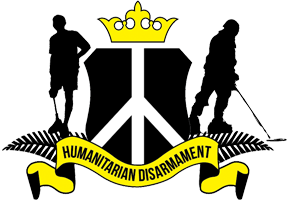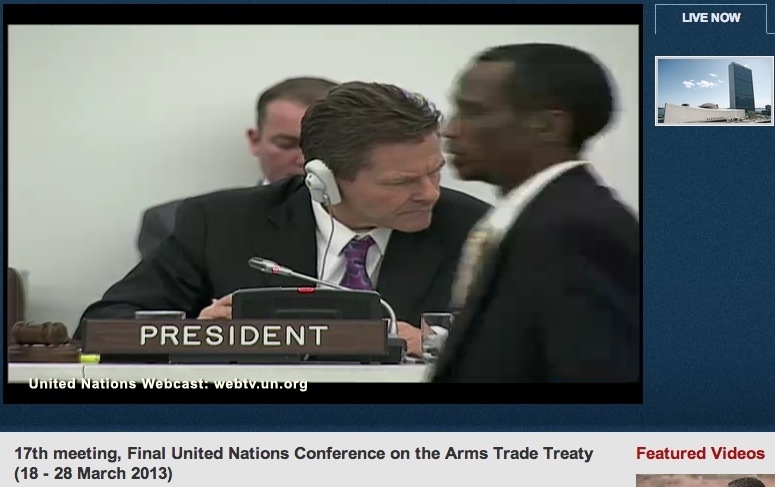Something remarkable happened at the United Nations in New York on Thursday evening (March 28), when member states failed to adopt a long-sought treaty to regulate the arms trade. Politicians “deplored” the way in which agreement on the Arms Trade Treaty text had been “thwarted” by three of the world’s most abusive regimes: Iran, Democratic People’s Republic of Korea (DPRK), and Syria. UN Secretary-General Ban Ki-moon expressed “disappointment,” describing the failure as a “setback.”
Yet despite the bluster this apparent defeat is in reality a double-win for everyone in favour of the Arms Trade Treaty and working to advance humanitarian disarmament. It’s also a great example of how international law can be achieved when sustained civil society pressure ensures governments stick to the plan and do what they have committed to do.
After the previous Arms Trade Treaty conference held under President Moritan of Argentina collapsed in July 2012, states reconvened for two weeks starting March 18, 2013 to negotiate and adopt a treaty under a new president Peter Woolcott, Australia’s Geneva-based disarmament ambassador. At around 3.30pm on Thursday, March 28, Woolcott held a plenary session to discuss his updated version of the draft text, bluntly telling negotiators to “take it or leave it.”
In turn Iran, North Korea, Syria were given the floor to outline their opposition to draft text of the proposed Arms Trade Treaty. Mexico‘s delegation leader, Juan M. Gómez-Robledo, then laid down the gauntlet, proposing that the draft text be adopted despite the objections because there’s no formal definition of consensus in the UN. Nigeria, Japan, Costa Rica, and Chile supported the proposal, but Iran again objected, and Russia warned, “we should never ignore the views of the minority.”
Woolcott conceded that there was no consensus on adopting the text and said the conference report would reflect that. He then gave the floor to Kenya, which delivered a statement on behalf of a group of eleven states: Argentina, Australia, Costa Rica, Finland, Japan, Mexico, New Zealand, Nigeria, Norway, the United Kingdom, and–most crucially–the United States.
The joint statement said that after years of hard work “it is time to act.” and proposed that the draft text issued by the President and annexed to the report of the conference be sent to the UN General Assembly for a vote. Kenya presented a draft resolution calling on General Assembly to adopt the treaty text, which would then be opened for signature on 3 June 2013.
Nation after nation lined up to speak in support of the proposal as well as endorse the resolution. The US said it “deeply regrets” the lack of consensus, but would vote for the treaty’s adoption. A few more states objected as, ever-patient, the president gave Iran, North Korea, Syria and other opponents the opportunity to voice their opposition, dragging out adoption of the conference report for four more hours.
But putting up with the treaty opponents for a few more hours was nothing after seven years of the drawn-out process to conclude the treaty. And it didn’t matter, because the game was over the moment that the world’s biggest proponent of democracy endorsed voting the treaty into life. As Woolcott remarked on concluding the conference at 10.27pm, “A treaty will not emerge from this process, but a treaty is coming.”
The chief US negotiator, Thomas M. Countryman, later told the press that the US would support the treaty because it would promote global security, advance humanitarian objectives and curb illegal arms sales, all without affecting the constitutional right to bear arms. He reportedly said, “I would rather be on opposite side of Syria, Iran, DPRK than join them in criticism of this treaty.” The National Rifle Association can be added to that list.
In Geneva, at the Convention on Conventional Weapons and elsewhere, consensus decision-making has allowed a tiny minority of states to hamper progress to address disarmament concerns, from the abolition of nuclear weapons to a ban on white phosphorus. Yet major powers including China, Russia and the US have long defended the consensus procedure, including in the Conference on Disarmament, where there has been no substantive work since 1997.
Countryman told media there was no “inconsistency” in the US position on consensus, emphasizing that it was always part of the plan, as “we always knew that this could go to the General Assembly.” The 2009 UNGA resolution stated that the treaty must be negotiated on the basis of consensus, a key demand for the US vote in support of it.
Yet the US negotiator also emphasized that, “it is the desire of the vast majority of states to have all of the major importing states and exporting states support this treaty and ultimately sign and adhere to it.” It remains to be seen if the US jettisoning of consensus in the Arms Trade Treaty process will be replicated elsewhere or if the action represents a tentative step towards embracing humanitarian disarmament successes such as the 1997 Mine Ban Treaty, which is undergoing a US policy review.
Getting the US on board was a key aim for the United Kingdom, Australia, Japan, and some of the other governments seeking to create an Arms Trade Treaty. They adopted a long-term approach that included waiting out the Bush administration (by starting with “consultations” in 2006) and agreeing in 2009 to a consensus-based negotiation. Consensus-based negotiations typically result in lower standards in order to accommodate the lowest-common denominator, but the extent to which the final Arms Trade Treaty text was negatively influenced from this still needs to be considered.
Consensus was resisted by many NGOs participating in the campaign for the Arms Trade Treaty and their efforts were crucial in securing the governments’ exit route via the UN General Assembly in a 2012 UNGA resolution. As the irrepressible leader of the Control Arms campaign, Anna MacDonald of Oxfam, explained to The New York Times, “We have known all along that the consensus process was deeply flawed.” This view was shared across a range of governments and civil society groups seeking to tackle a range of pressing humanitarian disarmament challenges.
Tuesday’s vote on the UN General Assembly resolution to adopt the treaty will provide the movement with clarity for its next phase of work by clearly identifying the states that are committed to implementing the treaty’s provisions and those who were just along for the ride. Tune in and to watch the vote to see the Arms Trade Treaty coming into being.
The core provisions of the Arms Trade Treaty will be examined in another post once it is adopted.
UPDATE – The Arms Trade Treaty was adopted on 2 April 2013 by a vote of 154 in favor, three opposed, and 23 abstentions. It will be opened for signature on 3 June 2013.
See also:
- UN summary of 28 March 2013
- Reaching Critical Will summary of 28 March 2013
- Reuters post by Anna MacDonald, Oxfam
- Post on ‘final’ negotiating conference in July 2012
- Post on the problem with the Conference on Disarmament


Leave a Reply